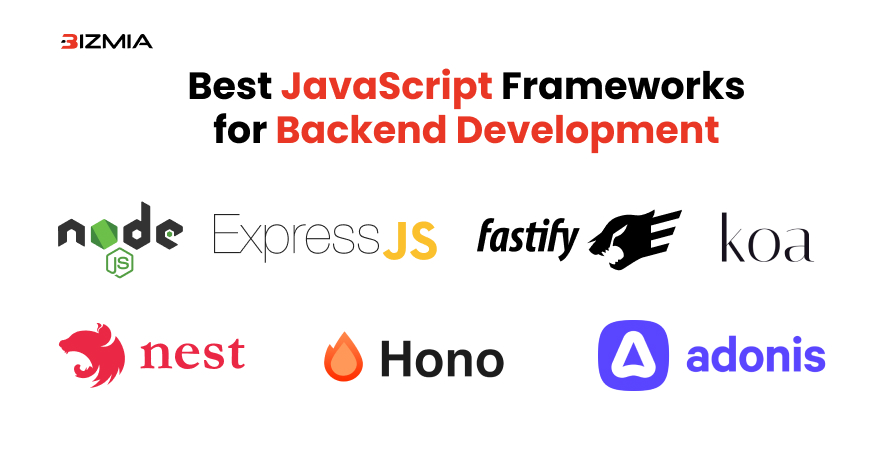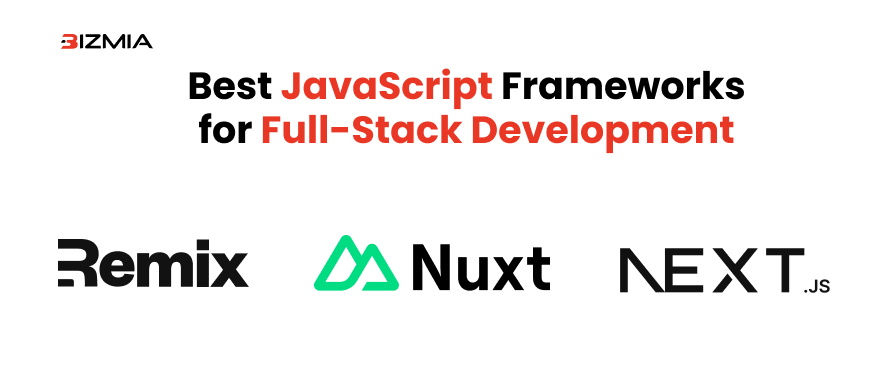From basic animations to complex server-side applications, JavaScript is the best choice for web development. With existing frameworks refining capabilities and emerging latest frameworks, JavaScript is still evolving in 2025. That’s why it is still popular among web developers for web projects. This blog enlists and talks in detail about the best JavaScript frameworks for web development in 2025. You can select any of them for front-end, backend, and full-stack web development.
What are JavaScript Frameworks?
These JavaScript frameworks are the pre-written collections of code that developers utilize to streamline and simplify the development of web applications. To design and organize web applications, top JavaScript frameworks offer structured ways. Moreover, to manage apps, these frameworks are packed with tools, suitable architecture, and defined rules.
Also, frameworks can be frontend, backend, and full stack as per the project requirements.
Criteria to opt for the Best JavaScript Frameworks
Certain factors are involved in the selection of top JavaScript frameworks for web development including:
- How fast any framework runs and uses resources
- Strong community support for JavaScript frameworks
- Scalability of framework with growing app demands
- The learning curve of a particular framework
- Availability of development tools, integrations, and extensions
- Popular frameworks tend to have better support in long term
Best JavaScript Frameworks for Frontend Development
We have collected some most popular JavaScript frameworks for frontend development including React.js, Vue.js, SvelteKit, Angular 16+, Solid JS, and Qwik, Let’s get into details with relevant coding examples:

1. React.js
Due to its massive ecosystem and component-based architecture, React.js frontend framework remains one of the most popular JavaScript frameworks. It also backs both server-side and client-side rendering, which makes it a highly versatile platform.
Here is the coding example with React.js:
import React from ‘react’ ;
function App ( ) {
return < h1 > Hello , React 2025 ! < / h1 > ;
}
export default App ;
Are you planning your next web development project?
2. Vue.js
With powerful features, Vue.js gives a gentle learning curve. Vue 4 technology includes reactivity, built-in TypeScript support, and improved performance. It’s a progressive JavaScript framework with a unique improvement, that is ref function. This function makes the creation of reactive references easy. Moreover, highly skilled front-end developers can assist companies in building scalable web solutions.
Coding Example:
< template >
< h1 > {{ message }} < /h1 >
< / template >
< script >
export default {
data ( ) {
return {
message : ‘ Hello Vue 4! ’
};
}
};
< / script >3. SvelteKit
You can compile your code into efficient vanilla JavaScript at build time with the SvelteKit framework. It results in smaller bundle sizes and faster performance of applications.
This given code can be followed for web development with SvelteKit:
< script >
let name = ‘ World ’ ;
< / script >
< h1 > Hello { name } ! < / h1 >4. Angular 16+
A full-fledged web development framework like Angular 16+, is ideal for enterprise-level web applications. Moreover, this JavaScript framework introduces improved developer tooling, better performance, and standalone components.
Code Example for Angular:
@ Component ({
Selector : ‘ app – root ' ,
template : ‘ < h1 > {{ title }} < / h1 > ’
})
export class Appcomponent {
title = ‘ Angular 2025 App ’ ;
}5. Solid JS
This one is a reactive UI library of JavaScript. Solid JS ensures excellent performance, and it has no virtual DOM and compiles its templates to real DOM. Moreover, this library backs all expected advanced library features.
A Detailed Practical Coding Example:
import { createSignal } from ‘ solid – js ’ ;
function App ( ) {
const [ count , setCount ] = createSignal ( 0 );
return (
< button onClick = {( ) = > setCount ( count ( ) + 1 )} >
Count : { count ( )}
< / button >
);
}
export default App;6. Qwik
This relatively new framework Qwik, can deliver instant loading web apps at any complexity or size. Instead of hydration, it benefits from a resumability model. Also, with Qwik you can ensure consistent performance on a scale.
You can follow this relevant coding example:
import { component$ , useSignal } from ‘ @ builder . io / qwik ’;
export default component$ (( ) => {
const count = useSignal ( 0 );
Return (
< button onClick$ = {( ) => count . Value ++ }> Count : { count . value } < / button >
);
});Best JavaScript Frameworks for Backend Development
Some of the most popular JavaScript backend frameworks include Node.js, Fastify, NestJS, Hono, Koa.js, and AdonisJS. Let’s understand them in detail:

1. Node.js and Express
Node.js is the cornerstone of several backend applications. When combined with Express, it provides speed and simplicity for microservices and RestFul APIs. If you compare Laravel vs Node.js, both are popular for backend development, but Node.js excels in building real-time apps.
Code Example:
const express = require ( ‘ express ’ ); const app = express ( ); app . get ( ‘ / ’ , ( req , res ) = > res . send ( ‘ Hello from Express . js!’ )); app . listen ( 3000 );
2. Fastify
Another backend JavaScript framework, Fastify, is focused on performance. It is getting famous due to its simplicity and speed. Moreover, it has minimal overhead, architecture, and powerful plugins. It is popular as one of the fastest Node.js frameworks for web development.
Let’s have a look at the given example:
const fastify = require ( ‘ fastify’ ) ( );
fastify . get ( ‘ / ’ , async ( ) => {
return { hello : ‘ world ’ };
});
fastify . listen ({ port : 3000 });3. NestJS
This framework uses TypeScript and is progressive in nature. It is ideal for enterprise applications because it follows OOP, FRP, and FP principles. Moreover, it offers built-in features for database management, integration, and authentication.
@ Controller ( )
export class AppController {
@ Get ( )
getHello ( ) : string {
return ‘ Hello from NestJS! ’;
}
}4. Hono
Optimized for modern runtimes such as Bun and Deno, Hono is a lightweight framework of JavaScript. It is ideal for serverless and edge-deployed web applications. Moreover, it is suitable for advanced APIs and web applications due to its efficient and ultra-fast architecture.
Here’s how to do coding with Hono:
import { Hono } from ‘ hono ’ ;
const app = new Hono ( ) ;
app . get ( ‘ / ’ , ( c ) = > c . text ( ‘ Hello from Hono!’ ));
export default app;5. Koa.js
Koa.js is a Node.js framework which is modular and lightweight in nature. Also, better control over the middleware can be achieved. It is one of the latest JavaScript frameworks, making code shorter by using JavaScript generators:
const Koa = require ( ‘ koa ’ );
const app = new Koa ( );
app . use ( ctx => {
ctx . Body = ‘ Hello from Koa! ’ ;
});
app . listen ( 3000 );6. AdonisJS
Inspired by Laravel, AdonisJS is a web framework popular for building customized backend applications and API servers. It also offers support for ORM, authentication, and routing. With Adonis, you do not need to find and assemble dozens of packages together.
Here’s how you can register routes with AdonisJS:
import Route from ‘ @ ioc : Adonis / Core / Route ’;
Route . get ( ‘ / ’ , async ( ) => {
return ‘ Hello from AdonisJS! ’;
});Best JavaScript Frameworks for Full-Stack Development
Although the best frontend JavaScript frameworks and backend frameworks are there in the market, it is also packed with the top full-stack web frameworks including Next.js, Nuxt 4, and Remix.

1. Next.js
For developers Next.js is a go-to framework for full-stack web development. It supports API routes, static site generation, and server-side rendering. Also, it automates many web development processes.
Example:
export async function getServerSideProps() {
return { props: { name: 'Next.js' } };
}
export default function Home ({ name }) {
return < div > Hello from { name } < / div >;
}2. Nuxt 4
This full-stack framework, which is built on Vue.js, offers powerful features, static generation, and SSR for web development. These features make it a suitable platform for designing SEO-friendly web applications.
See this coding example of using Nuxt 4:
< template >
< div > {{ greeting }} </ div >
< / template >
< script setup >
const greeting = ‘ Hello from Nuxt 4 ’ ;
< / script >3. Remix
Remix focuses more on fast data loading and web fundamentals. It’s a full-stack framework enabling better server/client integration. Remix also offers slick, fast, and resilient user experience.
Code example for a Remix project:
import { json , LoaderFunction } from ‘ @ remix – run / node ’;
import { useLoaderData } from ‘ @ remix – run / react ’;
export let loader : LoaderFunction = async ( ) => {
return json ({ message : ‘ Hello from Remix! ’ });
};
export default function Index ( ) {
const data = useLoaderData ( );
return < h1 > { data . message } < /h1 ;
}Conclusion
In 2025, various best JavaScript frameworks are there, taking care of all your web project requirements, be it backend, frontend, or full-stack development. You can make the right choice for your stack by understanding them in detail as discussed in this blog. Moreover, while considering the best fit for your web development task, always keep in mind your project needs and team skills.
Are you still confused about selecting the right JavaScript framework?
FAQs
1. Which is the best JavaScript framework for backend web development in 2025?
In 2025, for faster performance and lighter projects, Svelte and Vue.js are popular and React remains the top choice due to its massive ecosystem and versatility.
2. Which JavaScript framework is most popular for front-end development?
For ease-of-use Vue is good, SolidJS and Svelte are best for speed, and for building complex applications, Angular and React are the most favorite ones.












